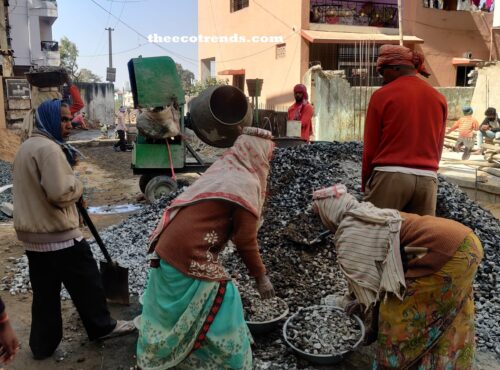Different activities may generate waste which may be solid or liquid. The quality of both solid and liquid wastes is increasing and if the wastes are disposed in an uncontrolled manner these may cause adverse impact on public health and environment. Hence these wastes need to be managed efficiently so as to safeguard public health and environment. In definitional terms, solid and liquid waste management is the collection, transportation, processing, recycling, treatment and disposal of waste materials.
The quantity of waste generated is increasing in rural areas as a result of increased population, consumerism and commercial activities. It is estimated that 15,000 to 18,000 million litres of gray water and 0.3 to 0.4 million metric ton of solid waste are generated each day in rural areas. Although the quantity of waste generated in rural areas is increasing, it is still relatively low compared with urban areas.
Reduction of Garbage
The accumulated form of unwanted and thrown out waste materials is called as garbage. It is the type of stuff that is not needed by anyone. All the wastes like cans, bottles, paper, kitchen waste and plastic bags are called garbage. Some of the things contained in the garbage can be re-used, still they are thrown away.
Garbage creates ugly scene wherever it accumulates. Its constituents start decomposing and releasing unpleasant smell. It serves as breeding place for germs of diseases, mice, worms, and insects that either serve as pathogens or are carriers of diseases. When wind blows or rain water falls on it, its decomposed part is blown away from place to place making the whole surrounding ugly and unhygienic.
Waste or garbage should not be thrown away. It should be reduced and disposed properly in view of healthy and pleasant community life. The reduction and disposal of garbage can be called as waste management or the garbage management. A basic 3R strategy is usually employed for the management of garbage at household level. These 3Rs mean- Reduce, Re-Use, and Re-Cycle.
Methods of Safe Disposal of Wastes
There are many different methods of safe disposal of wastes. These are being described below –
Collection and Segregation
Solid wastes should not be thrown out here and there. Instead, these should be collected in different containers according to their nature. For example, all the biodegradable wastes should be put into one container whereas all the non- biodegradable wastes should be kept into some other container. The non- biodegradable wastes should be segregated and kept separately. For example, plastic and metal scraps should be kept in separate bins after segregating them carefully. Metal scraps, bottles, plastics etc. can be sold to kabadiwalas.
Some state municipal bodies have started Double Dustbin Programme in which one dustbin should be meant for non-biodegradable waste. The dust-bin containing biodegradables should be green in colour while that meant for keeping the non-biodegradable wastes should be blue in colour. The non-biodegradable wastes may also be segregated according to their chemical nature and extent of toxicity.
Dumping of Waste
The word ‘dumping’ means carrying out the wastes and leaving the same carelessly on certain place usually in the open. In general, a ‘dump’ is the site which is used to dispose of solid wastes without environmental considerations. But, the unscientific dumping of wastes is often hazardous to the public health.
As usual practice wastes are dumped either on land or into water bodies like ponds, and lakes. Many countries dump their wastes on large scales into sea-water. All of these practices are totally unscientific and hazardous to the environment.
The scientific method of disposal of solid wastes into low land sites, without creating hazards to the public health or safety, is called as Land Filling.
There are three methods of land filling — area method, trench method and ramp method.
In Area Method, solid wastes are pulverised and spread over the entire areas. Then, it is compacted by the rolling of bull-dozers. A layer of soil is spread over the layer of solid wastes and the entire area is again pressed by rolling bull-dozers.
In Trench Method, trenches measuring 10 x 15 x 20 feet are dug and heaps of solid wastes are put into them. These trenches are compacted by rolling of bulldozers. The tops and sides of trenches are covered with soil. This method needs at least one acre of land to handle the solid wastes generated by about 10,000 people in a time period of one year.
In Ramp Method, a number of gullies, ravines or quarries are dug for land filling. Natural gullies made by soil erosion may also be filled. Solid wastes are dumped along the slopes, then covered with soil and pressed properly.
The selection of a site for land filling is done on the basis of following considerations:
(i) Availability of land and area.
(ii) Accessibility to the landfill site.
(iii) Availability of soil for the use as cover material.
(iv)Climate of the area in which the landfill site is located
(v) Topographic features of the land chosen for land filling.
Advantages of Land filling
(i) Flies, rats and other pests cannot breed in landfills.
(ii)Chances of fire hazards are reduced through this method.
Disadvantages of Land filling
(i) Land filling may cause ground water pollution by leaching down of Liquified wastes during rains.
(ii) If near a water source, a landfill may cause water pollution.
(iii) Land filling sites become unfit for the human settlement due to release of gases like methane and carbon dioxide within first two years. These gases are produced when the waste substances filled inside the ground start decomposing.
An Ideal Landfill
A scientific and ideal landfill should have provisions for checking the leachate against going deep underground and contaminating the ground water. For this, it should be sealed at the bottom by clay or plastic liners. Some ideal landfills have gas extraction system also, in order to release gases like methane and carbon dioxide that are liberated during the decomposition of wastes. These gases should be burnt to produce power as these may otherwise contribute to greenhouse effect, if released into the atmosphere. The landfills containing hazardous matter should have proper management systems to check the leaching of wastes and their recovery.
Feature Image: Hindustan Times




